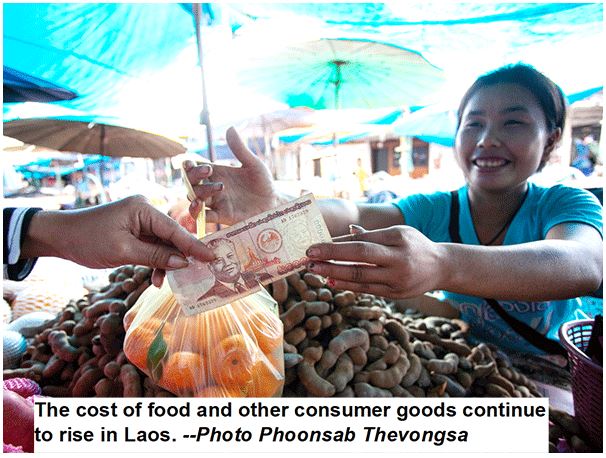Laos: Spiralling inflation causing increasing hardship
The Asian Development Bank has predicted that the annual average rate of inflation in Laos will jump to 5.8 percent in 2022 and 5.0 percent in 2023.
Inflation will be driven by higher oil prices, rising domestic demand, and the continuing depreciation of the kip, according to the ADB’s Asian Development Outlook (ADO) 2022.
The Russia-Ukraine conflict has heightened geopolitical uncertainty and rattled commodity and financial markets amid the Covid pandemic.
In addition, rising global inflation and geopolitical tensions will increase pressure on the price paid for imported goods in Laos.
“The kip depreciated by an annual average of 7.6 percent against the US dollar in the official market last year and by 12.1 percent in the parallel market on international bond maturities coming due and foreign exchange shortages,” the ADB report stated.
The continuing depreciation of Lao kip caused the price of imported goods to rise, especially petroleum products and construction materials. Authorities increased oil prices about 13 times in 2021.
Since the start of this year, authorities have again hiked fuel prices several times. The latest increase was announced on April 29, raising the price of premium grade petrol in Vientiane to 20,620 kip per litre, regular grade to 18,060 kip, and diesel to 18,000 kip.
Rising fuel prices forced transport operators to bump up their prices when the price of fuel and gas rose by 49.7 percent year-on-year in March, according to the latest report from the Lao Statistics Bureau.
In March, the year-on-year inflation rate surged 8.5 percent, even more than expected, and rose to the highest figure recorded since January 2016.
Inflation will add to Laos’ debt distress, which is already at high risk, the ADB said.
“Public and publicly guaranteed debt was last reported at 78.8 percent of GDP in 2021. Domestic expenditure arrears, lower economic growth, and the weakening kip in 2021 contributed to the increasing level of debt. The Lao PDR’s external public debt servicing requirements are sizeable, and are expected to average US$1.3 billion annually over the next five years, equivalent to 7 percent of GDP,” the report stated.
The government is concerned about how high prices are affecting Lao households, especially the poorest people.
At the last monthly cabinet meeting held on April 26-27, the government ordered the bodies concerned to control the price of fuel, consumer goods and currency exchange rates, to ease the burden on the general public.
Chaired by Prime Minister Phankham Viphavanh, the meeting instructed government officials to further improve the investment climate and push for the full implementation of planned mega projects, as well as overhaul the management of importing businesses to ensure that sufficient foreign currency enters the banking system.
Source: https://www.vientianetimes.org.la/freeContent/FreeConten85_spiralling_22.php


 English
English




